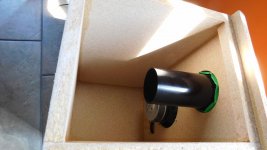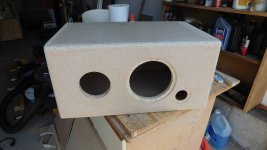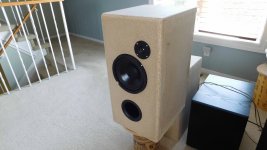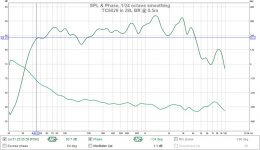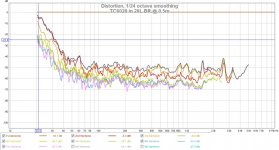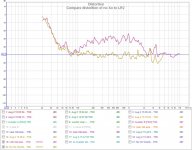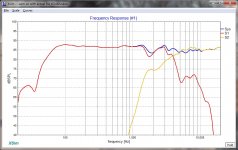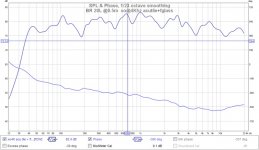 I was looking at 6.5" + a 2.5 or 3" full-range, but sensitivity of the small drivers is quite low and was worried about it being too bass heavy. Yours looks to be well balanced! 🙂
I was looking at 6.5" + a 2.5 or 3" full-range, but sensitivity of the small drivers is quite low and was worried about it being too bass heavy. Yours looks to be well balanced! 🙂 Tony.
Awesome! What a great idea to avoid the need for crossover components!
Subjectively, how do you like the way it sounds?
Subjectively, how do you like the way it sounds?
I just saw this thread, and I'm very excited to see what people come up with. I was just looking for a design at under $100 for a pair, excluding cabinetry and some of these would have been just perfect. I'm excited to see what is on the table come September.
I settled for a single FR driver in a small ported box. Perhaps I could have done better with some of these TM designs?
I settled for a single FR driver in a small ported box. Perhaps I could have done better with some of these TM designs?
I was looking at 6.5" + a 2.5 or 3" full-range, but sensitivity of the small drivers is quite low and was worried about it being too bass heavy. Yours looks to be well balanced! 🙂
Tony.
Those measurements were separate driver tests just to verify the enclosure was sealed and leak free. The rolls off points and slopes were checked against the HornResp design and it matches very well.
You're correct, the woofer is more sensitive at about +4db ref the fullrange. I actually prefer this for listening, but it may need to be adjusted to maximize contest points.
Awesome! What a great idea to avoid the need for crossover components!
Subjectively, how do you like the way it sounds?
I'm pleasantly surprised so far, cause it actually worked 😉 and it sounds good. I've been listening to it for the last 2hrs or so, and I'm really happy with the bass coming from a 6.5" woofer. I know there are audio artifacts in there, when both drivers are running, but they seem to be masked out more than I was expecting. It's hard (but not impossible) to tell there's no electrical crossover.
I only built one, so I have to drive it with a mono signal, and can't comment on imaging. If I like I'll produce another to find out. I have more drivers but I was saving them for a different design.
I guess using two channels one for each driver and just reducing the line level before the woofer one would work well if you want to go for a flatter response. I must say it is a very ingenious way of meeting the challenge! 🙂
Tony.
Tony.
That's exactly what I do during testing.
I use a stereo amp and can use the L/R balance controls to change the relative volumes of the drivers if I want to. It also allows me to mute one driver and listen to the "residue" from the other driver. Makes measuring with REW really easy too. I also have an amp capable of driving a 2ohm load when I eventually connect both drivers to a single channel.
I use a stereo amp and can use the L/R balance controls to change the relative volumes of the drivers if I want to. It also allows me to mute one driver and listen to the "residue" from the other driver. Makes measuring with REW really easy too. I also have an amp capable of driving a 2ohm load when I eventually connect both drivers to a single channel.
Traditional 2 way
This is my second, a more traditional bass reflex design. It uses a 6.5" woofer TC-6028 ($12, same as in previous BP6) with a small tweeter TD20F-4 ($8) leaving me $10 for XO parts (still waiting for parts delivery ).
A few construction pics.
This is my second, a more traditional bass reflex design. It uses a 6.5" woofer TC-6028 ($12, same as in previous BP6) with a small tweeter TD20F-4 ($8) leaving me $10 for XO parts (still waiting for parts delivery ).
A few construction pics.
Attachments
Looks good! I'll be interested to see the woofer measurements, I wish PE would post graphs of their buyouts (not that I could afford the shipping on them anyway).
Tony.
Tony.
Thanks. The drivers have to be pretty cheap for me to take a chance on them when basic data is missing. The reviews and ratings seem to indicate people do like these, and at $12 it's less than lunch 🙂. I have no complaints so far about this driver (TC-6028).
I ran a few tests to check the box tuning and the driver. It's pretty close to the HornResp predictions using the average T/S parameters that I could find. Since the port is out the front, the response is for both combined at 0.5m. I think it's a little bumpy because there is no fill in the cabinet. I needed it to hit 3Khz for the XO to the tweeter and it just makes it 😀. That's a bargain for $12.
I ran a few tests to check the box tuning and the driver. It's pretty close to the HornResp predictions using the average T/S parameters that I could find. Since the port is out the front, the response is for both combined at 0.5m. I think it's a little bumpy because there is no fill in the cabinet. I needed it to hit 3Khz for the XO to the tweeter and it just makes it 😀. That's a bargain for $12.
Attachments
How about the TD20F-4 - the specs look great for it, sound good?
https://www.parts-express.com/pedocs/specs/275-104--dayton-audio-nd13fa-4-spec-sheet.pdf this also looked really good at near same price.
https://www.parts-express.com/pedocs/specs/275-104--dayton-audio-nd13fa-4-spec-sheet.pdf this also looked really good at near same price.
Jared, that tweeter you linked to would make a nice super tweeter to cross in high with a full range. The nearly 3Khz resonant frequency means you would not want to be crossing lower than about 6Khz and preferably higher I would think.
The TD20F-4 was what I had saved for a possible two way with an MCM 6.5" polycone. Actually I posted what I was playing around with in post #155 🙂
Tony.
The TD20F-4 was what I had saved for a possible two way with an MCM 6.5" polycone. Actually I posted what I was playing around with in post #155 🙂
Tony.
My XO parts are still in transit. I'll scrounge to see if I can find a few components for a temporary test XO on the tweeter. I'm curious myself. Maybe later today or tomorrow.
XO for the 28L BR
I received some parts and scrounged others to make up an LR2 @3Khz.
I was looking at these really low cost inductors typically sold from the far east. There are no specs other than the inductance. However they must have high magnetic permeability cores in order to get that much inductance in a small low cost package. I prefer air core inductors, but these were cheap enough to take a chance. 🙂 Pic#1 shows them.
The tweeter is attenuated to remove a rising HF curve and produce a flatter but attenuated curve. Graph#1
The downside. The cheap inductors are in series with the woofer and cause a significant increase in THD (100Hz-2Khz, graph#2). I added the woofer's THD curve without XO as a reference point. The distortion can be noticed, as some passages of music have less clarity and detail. [sigh]. On the upside, it sounds more complete (full) with the tweeter running, and THD is not included in the contest 😀
I received some parts and scrounged others to make up an LR2 @3Khz.
I was looking at these really low cost inductors typically sold from the far east. There are no specs other than the inductance. However they must have high magnetic permeability cores in order to get that much inductance in a small low cost package. I prefer air core inductors, but these were cheap enough to take a chance. 🙂 Pic#1 shows them.
The tweeter is attenuated to remove a rising HF curve and produce a flatter but attenuated curve. Graph#1
The downside. The cheap inductors are in series with the woofer and cause a significant increase in THD (100Hz-2Khz, graph#2). I added the woofer's THD curve without XO as a reference point. The distortion can be noticed, as some passages of music have less clarity and detail. [sigh]. On the upside, it sounds more complete (full) with the tweeter running, and THD is not included in the contest 😀
Attachments
They look like the sort of inductors used in cheap PC power supplies. Quite a substantial increase in distortion for sure. I always thought that distortion with cored inductors was a problem if they were saturated, but this would suggest (at least with this type of inductor) it's not the case!
Tony.
Tony.
True, they are usually used as filter chokes in power supplies. Mine will eventually find their way into a power supply filter but I thought I "might" get away with it on this LR2 . I suspect its the usual hysteresis and eddy current losses that are a poor choice for an speaker filter. It's very unlikely the core is saturated, I use low power for testing. It would be interesting to test the saturation effect idea to see if distortion gets worse with increasing power.
Somone posted earlier the excellent idea of finding an old motor and using the wire from it to wind your own coils. Here are my blog entries for coil winding Rolling Your Own (an adventure in coil winding) part I - diyAudio rolling your own (an adventure in coil winding) part II - diyAudio
Tony.
Tony.
Thanks for the links, its a good idea. If I can find a donor I'd give it a try.
At one time it was possible to find candidates (motors, transformers) in the curbed garbage and salvage them to get the magnetic wire. Now it all has to be properly recycled and there are no electronics recyclers left (around here) that will sell scrap to the public.
At one time it was possible to find candidates (motors, transformers) in the curbed garbage and salvage them to get the magnetic wire. Now it all has to be properly recycled and there are no electronics recyclers left (around here) that will sell scrap to the public.
Another XO + fill for the BR 28L
This is an attempt to smooth the FR out a little more.
I created the FRD and ZMA files (REW export) for the woofer in the cabinet. Loaded them into Xsim with the files for the TD20F and played with the XO points until I got it as smooth as I could.
I also went in and added acoustic tile to the back (behind the woofer) and fibreglass fill to the bottom (port is not blocked) to dampen internal resonances and reflections. It had very little effect.
Included is the Xsim prediction and the actual measurement. I think that's as good as I can get it. Suggestions welcome.
This is an attempt to smooth the FR out a little more.
I created the FRD and ZMA files (REW export) for the woofer in the cabinet. Loaded them into Xsim with the files for the TD20F and played with the XO points until I got it as smooth as I could.
I also went in and added acoustic tile to the back (behind the woofer) and fibreglass fill to the bottom (port is not blocked) to dampen internal resonances and reflections. It had very little effect.
Included is the Xsim prediction and the actual measurement. I think that's as good as I can get it. Suggestions welcome.
Attachments
Last edited:
- Status
- Not open for further replies.
- Home
- Loudspeakers
- Multi-Way
- silk purse from sows ear contest?
